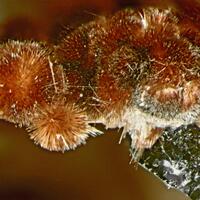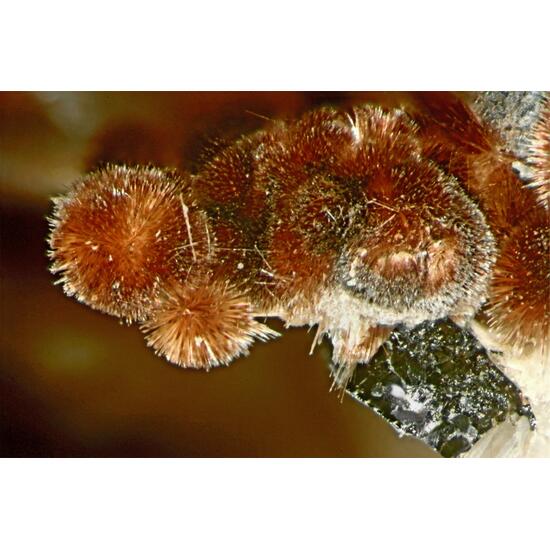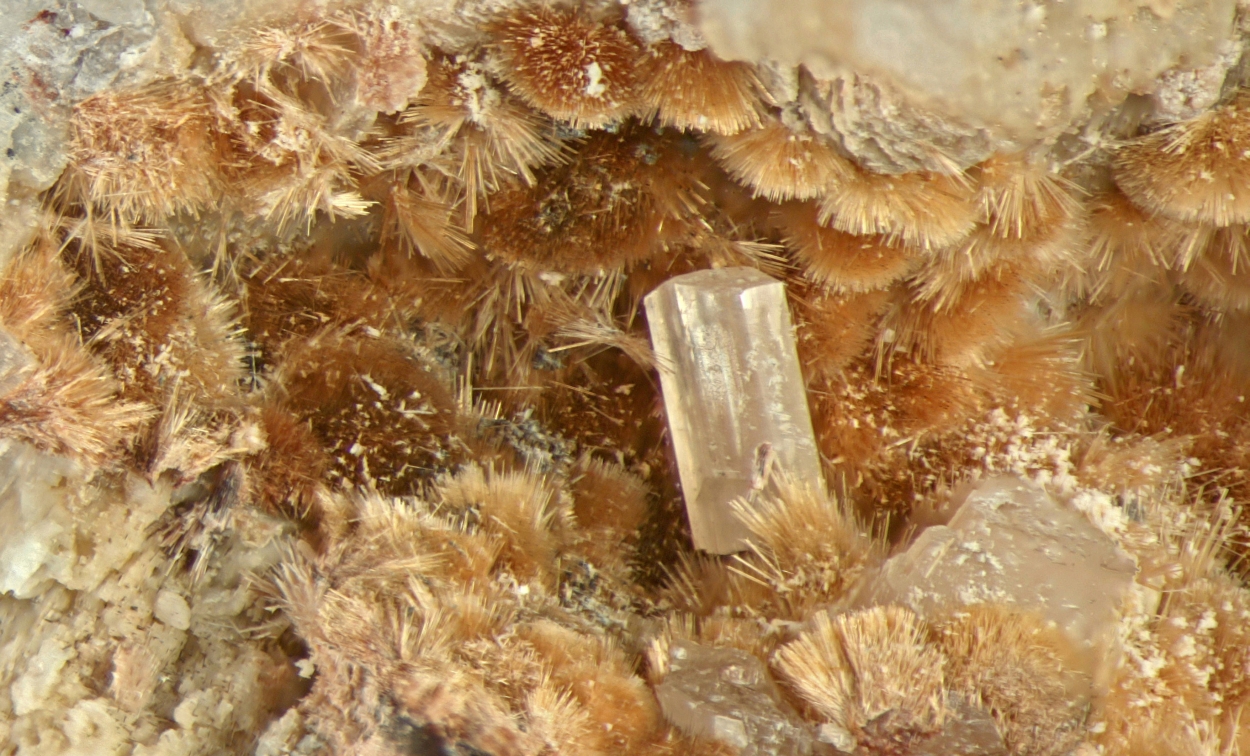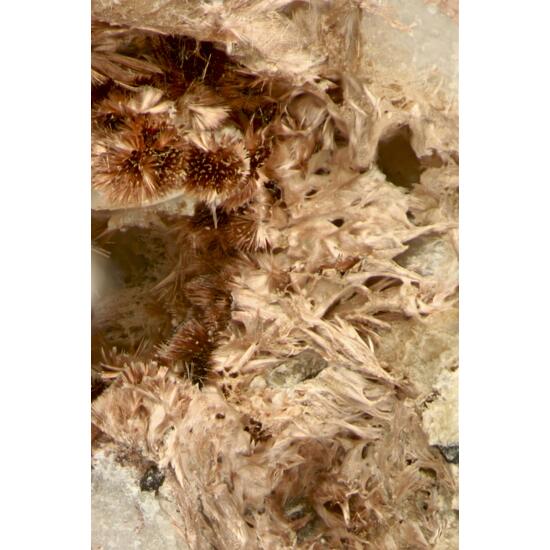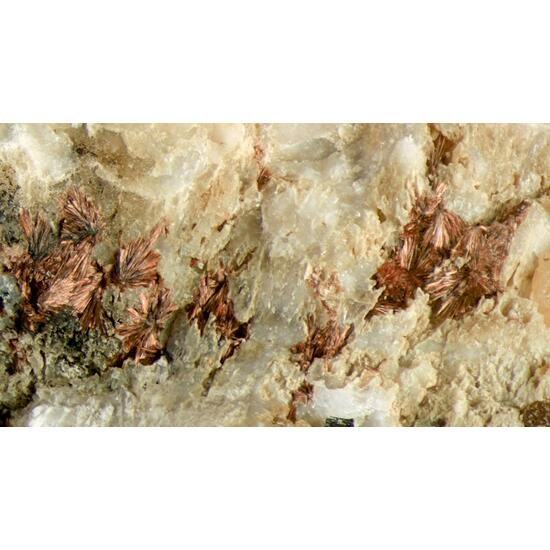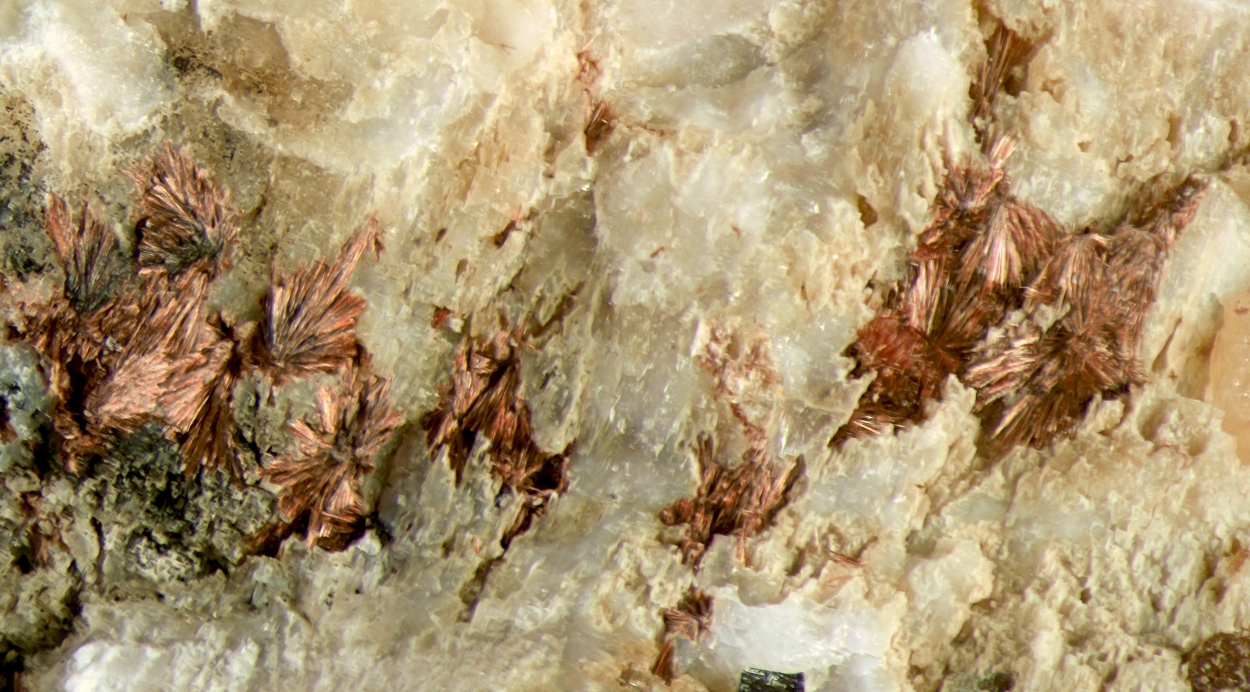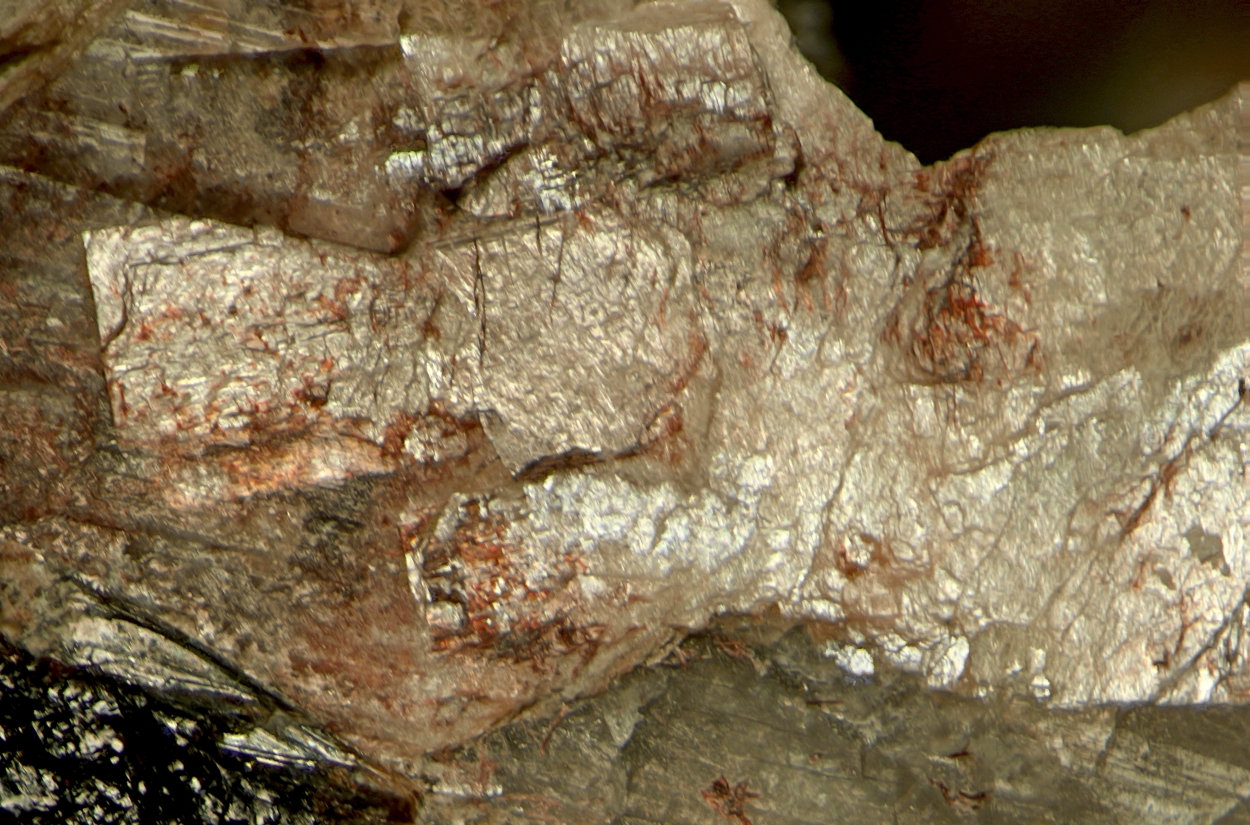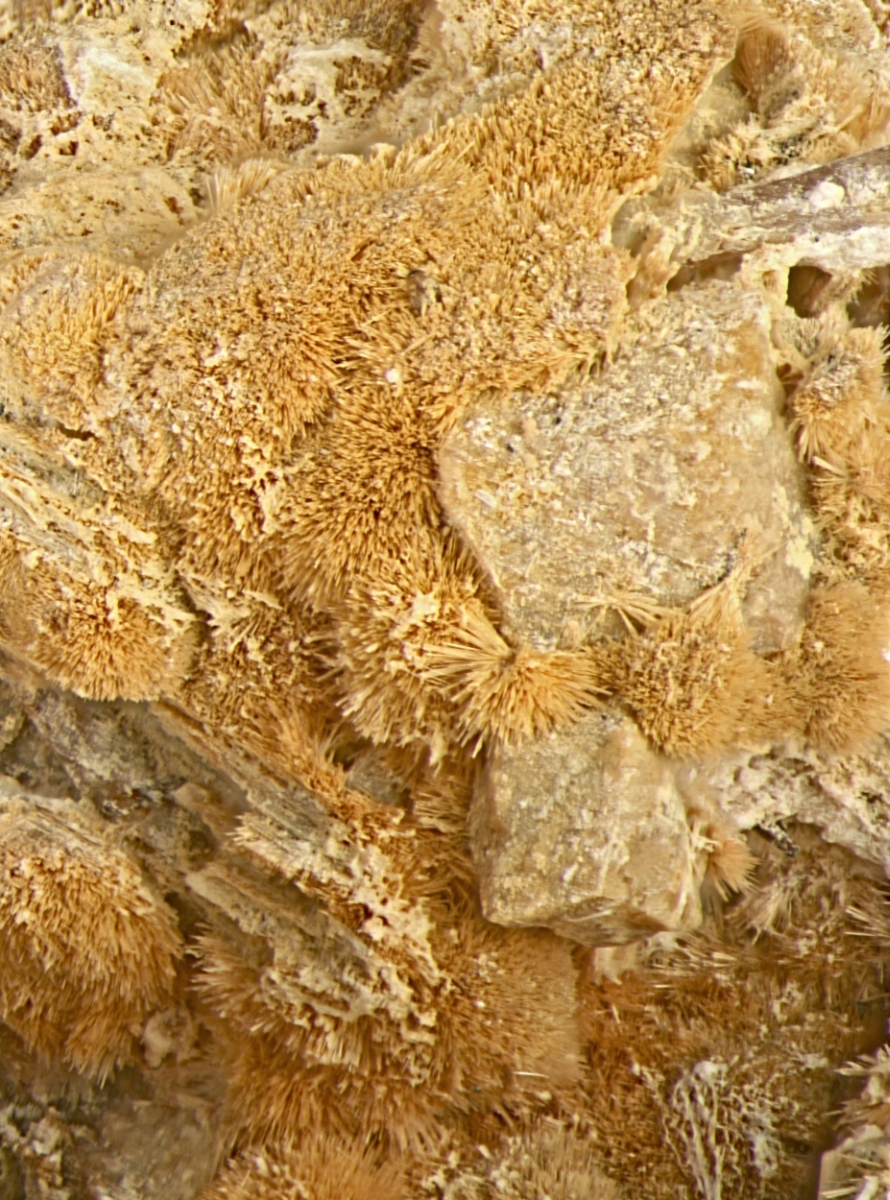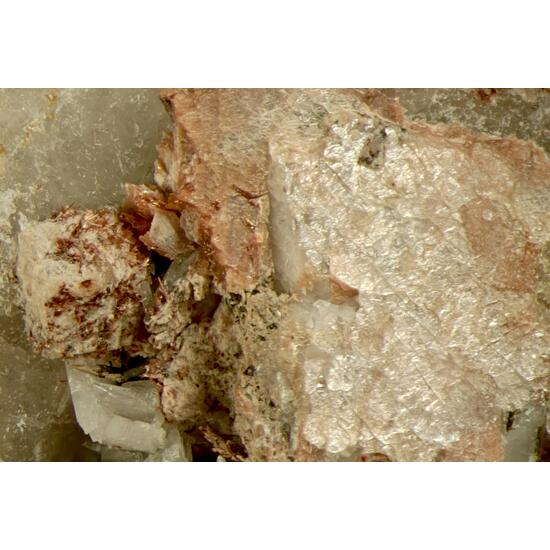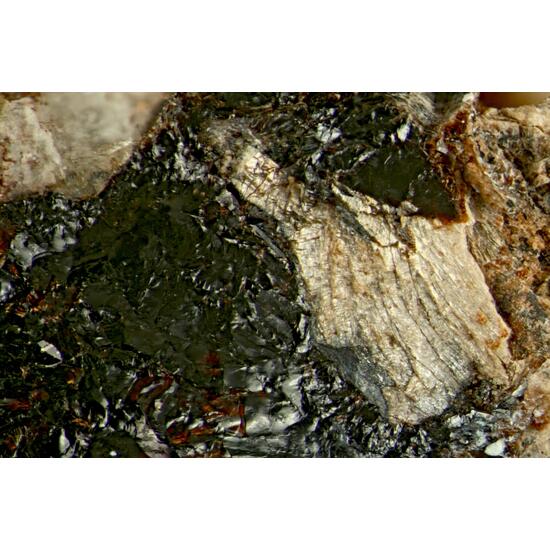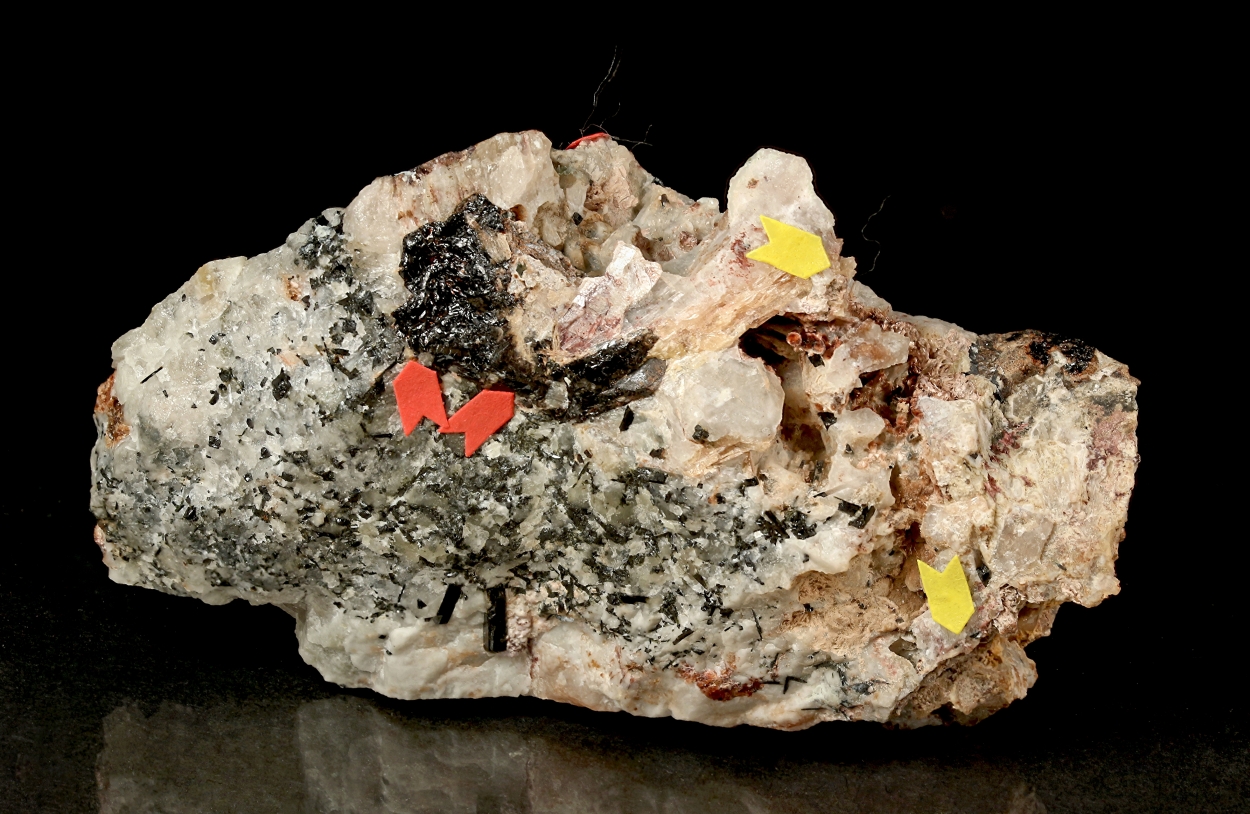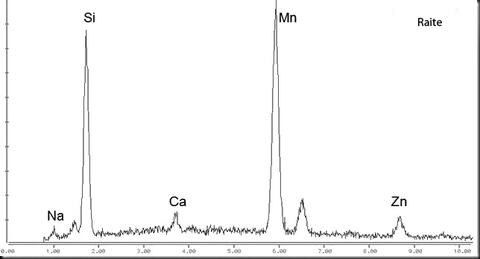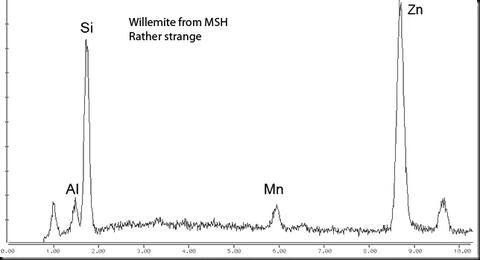This specimen features rich coverages of the rare mineral raite; several crystals, some euhedral, of the rare mineral epistolite; large (for MSH) masses of steenstrupine-(Ce); rare lovozerite (some altered to terskite), and several small, but well-formed crystals of sérandite. In addition, embedded in the matrix (which seems to be mostly massive analcime) are numerous rounded crystals of grayish glassy sodalite that have a bright orange LW UV fluorescence. Other minerals (none significant) are aegirine (with one or two terminations), polylithionite, and “eudialyte” (all broken). There are also a few unidentified things on the specimen. (EDS indicates the presence of willemite.)
There is a lot to look at under a scope. In fact, because of the 10 photo posting limit, I was unable to show all of the interesting things on the specimen. Some additional photos and stereo versions of some of the photos presented here can be seen on Mindat under minID 4Y3-1Q6. There is also a lot to describe – so take a deep breath.
The first photo (FOV 3.8 x 2.6 mm) shows nice raite spherules to ca 1.1 mm. (Compare with p. 371 in Igor Pekov’s “Lovozero Massif”.)
But there is a lot more raite on the specimen. The raite was confirmed on various specimens at the CMN via microprobe and also at the ROM via EDS. See the "Analysis tab" for a sample from another specimen. As shown in the photos, the color and habits vary greatly, but all analyzed samples were found to be raite - some enriched in Zn. There is no yofortierite or tuperssuatsiaite. Of course, it is not possible to analyze each and every little patch.
The second photo (FOV 6.1 x 3.7 mm) shows a crystal of sérandite (1.4 mm) among raite spherules of a more brownish color. There are several other terminated sérandite crystals, some larger, on the specimen. There are also larger (1+ cm), but broken, sérandite crystals of a yellow color reminiscent of vuonnemite (not shown). They do not fluoresce, so they are not actually vuonnemite.
The third photo (FOV 4.6 x 6.9 mm) show more raite spherules (<= 1.3 mm) along with much longer, curly, fibers of raite. As already noted, both the color and habit of the raite from this find varied widely. On this specimen, the raite color ranges from pale yellowish brown to intense red-violet (not shown).
FOV in the fourth photo is (6.4 x 3.5 mm). This is not the richest “patch” of raite on the specimen, but it has the most intense color. Color wise,iIt looks a lot like some MSH yofortierite. But as already noted, all careful analyses of this material have shown nothing but raite. The actual color is a bit more violet/purple. It is quite beautiful in person.
The fifth photo (FOV 6.9 x 4.5 mm) shows an euhedral epistolite “crystal” 3.3 x 1.6 mm. It is partly obscured by matrix (probably translucent analcime) and sits in/on more epistolite at one end. The red stains are raite “smears”.
This type of epistolite is highly reflective. In the photo, the epistolite looks very silvery. But the appearance depends greatly on the illumination. Getting it to look as in the photo is like Goldilocks and the porridge. The lighting has to be “not too hot and not too cold”. It has to be “just right” to avoid “blowouts” yet keep the epistolite from vanishing into the background. Which doesn’t mean that you will have trouble seeing it. The reflections will make it stand out strongly with just a bit of “twiddling”. The difficulty is in making a reasonable photo.
The sixth photo (FOV 4.5 x 6.1 mm) shows two brownish crystals of lovozerite, the largest about 2.2 mm in maximum diameter. They are surrounded by orange raite spherules, but in this case, everything is somewhat discolored by an unidentified coating. The lovozerite has not been analyzed, and possibly it is more or less altered to terskite. A more probable terskite pseudomorph is shown in the next photo.
The seventh photo shows more epistolite along with what a small (ca 1.3 mm on edge) whitish terskite pseudomorph after lovozerite, partly encrusted by raite. (See the "Analysis" tab..)
The epistolite on the right has a “typical” silvery/”crackly” appearance (like ceramic glaze), but in the center of the photo it looks distinctly pinkish and less “crackly”. Per Igor Pekov, pinkish lamellae of epistolite are apparently typical of epistolite from the Lovozero Masif.
As shown in the eighth photo (FOV 4.5 x 6.7 mm), some of the pinkish “epistolites” have an almost earthy looking core – not like epistolite at all.
At least at Lovozero, epistolite is apparently always a replacement of vuonnemite, which is very unstable under atmospheric conditions. But the replacement isn’t always epistolite. In Lovozero, at least eight other minerals have been found as replacements of vuonnemite. Of these, only “pryochlore” and nenadkevichite are minerals reported from MSH. But I don’t think that “epistolite” from MSH has been studied so closely that the other possibilities can be excluded.
Early on, it was thought that the mineral found at MSH was murmanite, which is a replacement of another unstable mineral – lomonosovite. Again, I don’t think that study of MSH “epistolites” has been exhaustive enough to absolutely exclude murmanite. (I have at least one candidate.)
So are these pinkish “crystals” really epistolite or some other strange beast? Strangely enough, two samples submitted for analysis, one pinkish the other mottled tan, came back as willemite! (See the “Analysis” tab.) So – apparently – this is yet another one of the weird and wonderful pseudomorphs from MSH. I don’t understand how this particular replacement makes sense geochemically, but I don’t understand many of the other pseudomorphs either.
The pseudomorph in this photo is relatively large. It runs about 7.6 mm along the diagonal. But I detect no UV response! Another very strange thing.
In the lower right corner are more raite sprays. I don’t know what the cream colored stringy stuff above the raite is. Above that is some “flaky” polylithionite seen edge on.
At least at Lovozero, epistolite is apparently always a replacement of vuonnemite, which is very unstable under atmospheric conditions. But the replacement isn’t always epistolite. In Lovozero, at least eight other minerals have been found as replacements of vuonnemite. Of these, only “pryochlore” and nenadkevichite are minerals reported from MSH. But I don’t think that “epistolite” from MSH has been studied so closely that the other possibilities can be excluded.
Early on, it was thought that the mineral found at MSH was murmanite, which is a replacement of another unstable mineral – lomonosovite. Again, I don’t think that study of MSH “epistolites” has been exhaustive enough to absolutely exclude murmanite. (I have at least one candidate.) So are these pinkish “crystals” really epistolite or some other strange beast? Without a specific analysis (which would be fraught with difficulties in any case), I can’t guarantee that, but they probably are.
The ninth photo (FOV 6.2 x 4.1 mm) shows a bit of the steenstrupine-(Ce) right next to some more epistolite. On this specimen, the two minerals are often close to each other. Note the typical conchoidal fracture and red highlights in the steenstrupine. I don’t know if the steenstrupine form this find has been analyzed, but material of identical appearance from a similar find made ca 2000 was shown to be steenstrupine-(Ce).
Altogether, there are several blobs of steenstrupine-(Ce), the largest about 8 x 12 mm. Two of the largest blobs can be seen at top center in the full-view photo.
Raite is known only from MSH, the nearby Demix-Varennes quarry, and three localities in the Kola Peninsula (including the Yubileinaya pegmatite, which is the TL). Raite is rare at MSH, but was relatively abundant in this well known find from ca 2003.
Single item shipping weight (small box, no case) is 5.9 oz. Up to a total weight of 8 oz (225 g), this could be combined with other items from this or future auctions for the same postage. If you wish to keep an “open box”, let me know. Please see my "Shipping Policy" for details.


